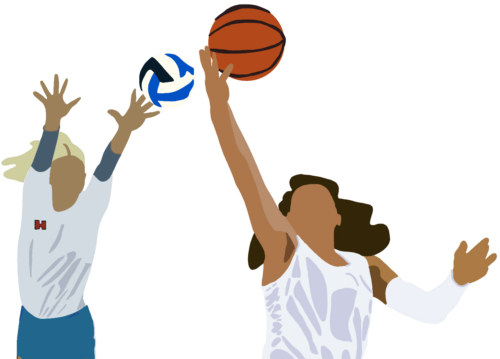On Jan. 14 and 21, four Boston-area collegiate women’s ice hockey teams competed in their biggest tournament of the season: the Beanpot. Bringing together students from Boston University, Boston College, Harvard, and Northeastern, this renowned athletic event has been occurring annually since 1952. However, while the Men’s Beanpot around two weeks later is accompanied by roaring crowds and a sold-out rink, the female hockey players are less lucky.
The 2025 Women’s Beanpot attracted 13,279 viewers, the largest audience in New England history. While these numbers seem cause for celebration, the Men’s Beanpot consistently draws over 15,000 people. Furthermore, since the Women’s Beanpot is scheduled before most Harvard students return from Winter Recess, such a discrepancy in audience is only exacerbated on this campus. Even beyond the Beanpot, college female athletes are waiting for comparable recognition and treatment both on and beyond campuses.
Since the average professional salary for American female athletes is only 83% of their male counterparts, collegiate female athletes often have to dedicate more time to being well-rounded—it is not as easy to rely on a sport without the prospect of a lucrative career ahead. Ultimately, such numbers expose the recurring discussions surrounding the ever-present divide between men’s and women’s sports. Moreover, the sexist portrayals of female athletes in the media perpetuate gender-based discrimination, leading us to question whether news broadcasts and sports journals are the problem—or if the larger societal culture is.
In March 2021, researchers at Purdue University demonstrated that, from 1989–2019, the percentage of women’s sports coverage compared to men’s had barely changed. In 2019, female athletics only accounted for approximately 5.4% of airtime on live television, only slightly higher than the 5% calculated in 1989. According to a campaign launched by Buick in 2022, “over 40% of all athletes are female.” Thus, offering them such little media coverage does not make sense, at least based on participation.
Additionally, the Purdue researchers explained that the quality of coverage in women’s versus men’s sports is drastically different: “In 2019, with rare exceptions…women’s sports stories were still normally presented in bland and boring ways. In contrast, viewers of stories about men’s sports were constantly immersed in a sea of colorful and dominant verbal descriptors, delivered in excited and widely-modulated voice intonations.”
Beyond inadequate televised exposure, depictions of female athletes in popular publications uphold discriminatory rhetoric in sports. A 2019 study published in Body Image, which traced the objectification of female Olympic athletes over the past sixty years in Sports Illustrated, explained that while men are often depicted as hypermuscular and talented, female athletes are often highlighted for their appearance, family life, and fulfillment of other stereotypically female gender roles.
On the one hand, it is not solely ESPN, Sports Illustrated, or other popular sports media’s fault for this discrepancy. It’s understandable that media outlets focus on what the public desires to consume, as increased viewership translates to higher revenue. This dilemma presents an interesting chicken-and-egg scenario: should increased media coverage and altered depictions of female athletes come first to drive interest in women’s sports, or must attraction come before viewership?
It is almost impossible for women to expand their audience if they do not have the opportunity. The lack of talent-centric, compelling, and consistent exposure of female athletes in the media inadvertently teaches the American populace that men’s athletes are more important and more captivating, as their sports remain one of the primary programs the public can consistently watch. Favorite players inevitably become LeBron James, not Nneka Ogwumike, and the Los Angeles Sparks are left in the shadow of the Lakers.
Redefining the portrayal of female athletes by emphasizing skills and team achievements over their appearance and status would transform the cultural narrative around women’s sports. Viewers would learn to respect and celebrate these professionals rather than compare and scrutinize superficial traits.
Additionally, an analysis conducted by audience research company GWI explains that there has been an increase in public engagement in women’s sports from 2021 to 2024. 28% of sports fans say they now follow or are interested in the FIFA Women’s World Cup, which is an 11% change since 2021. The WNBA saw a 7% change in public interest since 2021, with 19% of individuals now watching the league. The UEFA Women’s Champions League, the Women’s Tennis Association, and the International Cricket Council Women’s T20 all similarly are noticing climbing viewership, observing percentage changes of 13%, 9%, and 3%, respectively. To sustain this progress, we need to first intentionally alter national media.
As Makenzie Glassford of The Campanile comments, “Sports media is not waiting for us to get interested in women’s sports, it is creating our apathy.” Unless news broadcasts extend their air time when showing women’s sports and journals remedy their stereotypical gendered depictions of female athletes, American discriminatory perception of these individuals will not change.
On campus, male athletes should actively promote their female counterparts, both online and on the field. Instead of simply seeing one another at weekend mixers or athlete dinners, they should bring vibrant posters and their friends to every game. As the stands begin to fill, more students will realize the importance of supporting all Harvard athletes equally.
Sara Kumar ’27 (sjkumar@college.harvard.edu) is looking forward to attending Harvard women’s sports games this spring.

